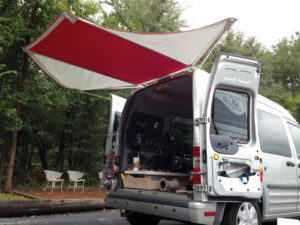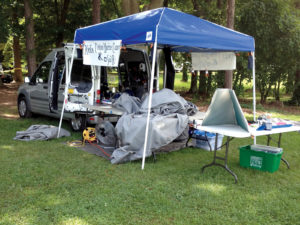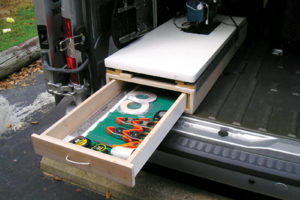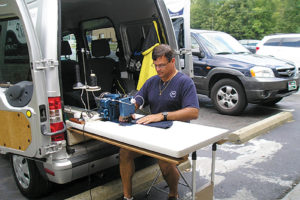A mobile sewing unit grows a business

A Ford Transit Connect is a practical vehicle to equip with a mobile sewing machine for onsite repairs.
As my canvas and sail repair business continued to grow, efficiency became critical. I needed a system that would accommodate me in doing offsite repairs with only one trip from the shop. I decided a mobile sewing unit could take me right to the customer site and allow me to complete the work immediately. What’s more, I could get paid in the same trip.
A positive return on investment
My solution had to be cost efficient for both the customer and me. Much of my work is on vessels on Lake Norman in the Cornelius, N.C., area. It was important to decrease the number of trips I make to each worksite, because Lake Norman is approximately 520 miles of shoreline. The marinas and private residential docks where I work number in the hundreds. My customer base was certainly ample, but investing in a mobile unit demanded the need for a positive return on investment.
After looking into several options, I decided on a Ford Transit Connect. At the time, this van was new to Ford dealerships in my area. After much research, I decided that this vehicle had the spacious cargo compartment that would fit all of my needs. The van, which was built in Turkey, was small enough to get great fuel efficiency as I covered the lake from one end to the other. The floor of the cargo space was particularly advantageous as it was lower to the ground, unlike most trucks and vans.
I worked closely with Karl, an engineer friend, to determine the best means for housing the sewing machine, creating space for tools and other accessories, and making it a comfortable work space.
The rear door of the van rotates 270 degrees, giving us complete access to whatever kind of table or housing unit for the sewing machine we decided upon. We developed a sliding table to house the rugged and versatile Sailrite® LSZ-1 sewing machine. The sewing machine can be run on a 110 volt or on a power converter from the van’s 12 volt system. We built a drawer under the table to house all of the supplies, tools and extra parts we might need for onsite custom repairs.
Custom considerations
When designing a mobile system of this style, several factors need to be considered. These include the sewing machine size, weight and capabilities; power sources both on the van and at the site; maintenance of the sewing machine because of exposure to outside temperatures and dirt; and maximum use of every inch of cargo space. After all, we have to be certain that we stock the supplies necessary to complete jobs on location.
We made custom tool pouches on the inside panels of the van to hold all of our hand tools. We do not use the sewing machine outdoors if the temperature is below 50 degrees F, due to the stress it puts on the machine. All of the equipment can be removed easily from the van for cleaning or maintenance. The drawer unit is held in with threaded bolts and wing nuts. The hand tool pouches on the sides are held in with screws and snaps.
Marina access issues
One of the challenges that we are beginning to encounter is permission from the marinas to work on their property. Here in North Carolina, marinas require proof of liability insurance. And some marinas charge a fee to outside contractors for taking up valuable parking spaces and using electricity on their property. Building up-front “relationship capital” with marina owners is key to the success of any onsite repair business.
In addition, I reviewed and updated my safety policies and practices to include the mobile unit. This included procedures for securely fastening sewing machines, tools and fabrication materials that are housed in the cargo space.
I have found some additional creature comforts that are helpful to our sewing staff:
- We made a small shade that extends from the roof rack and covers the sewing area to provide some relief from the sun.
- We mounted 4-inch plastic tubes to the ceiling to hold support poles, rulers and an umbrella.
Small jobs lead to bigger jobs
Much of the onsite work we do out of the van is finishing work on custom-made products. This includes final zipper placement and finishing furniture covers. Other work and quick repairs are mostly damages that are caused by the owner and need some type of quick patchwork. We continue to grow the business with what starts out as a minor on-location repair but evolves into a larger project.
The van also serves as good advertisement for the business and services we offer while traveling around the lake. It is safe to say, our mobile sewing unit has served us well over the past seven years.
Rick Berkey owns Rick’s Custom Canvas and Sail, Cornelius, N.C.
 TEXTILES.ORG
TEXTILES.ORG 










